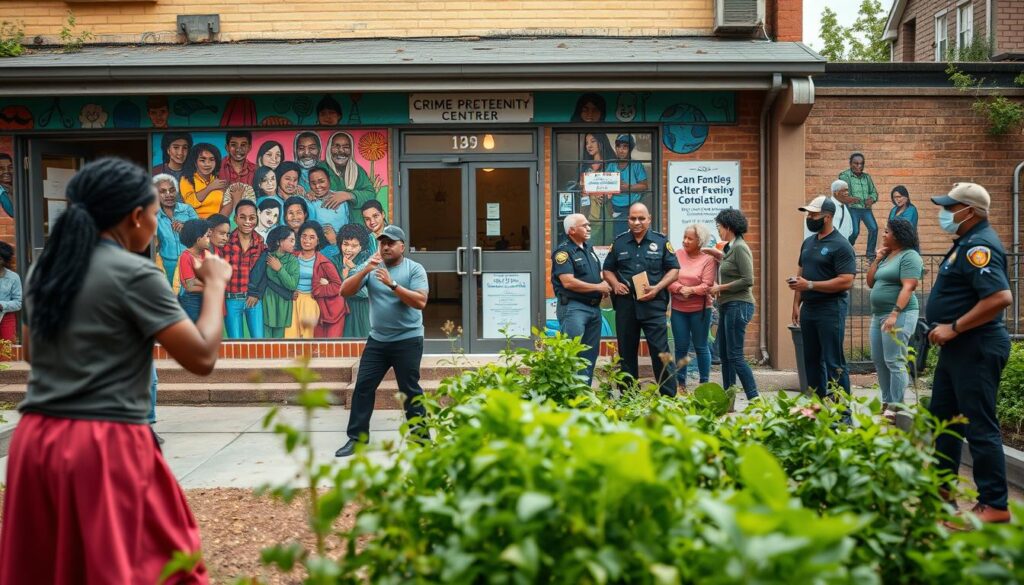Did you know the Government of Canada funds community-led crime prevention projects? This is through the National Crime Prevention Strategy (NCPS). This shows how important it is to know about crime trends and government efforts to stop crime.
Looking into crime rates in big cities like Toronto shows the need for good crime prevention plans. By looking at Canada crime stats and prevention efforts, you learn how communities and police make places safer.
Understanding Canada’s Crime Landscape
It’s important to know the trends and patterns in Canada’s crime rates. This knowledge helps in creating effective ways to prevent crime. Many things shape Canada’s crime scene, like economic conditions, how police work, and changes in the population.
National Crime Trends in Recent Years
The Royal Canadian Mounted Police has shared recent data. It shows Canada’s crime rate has changed over the years. Crime rates have been influenced by factors such as urbanization and economic conditions. For example, the crime rate has gone down a bit, but some types of crime have gone up.

How Canada Compares Globally
Canada’s crime rate is lower than many other countries. It’s among the safest places in the world, according to global crime statistics. But, like other countries, Canada struggles with violent and property crimes.
Key Factors Influencing Crime Rates
Many things affect crime rates in Canada. These include economic conditions, how police work, and how involved the community is. Economic instability and lack of opportunities can lead to more crime in some areas. Here’s a table that shows some of these factors and their impact.
| Factor | Impact on Crime Rate |
|---|---|
| Socio-economic conditions | High unemployment and poverty can increase crime rates |
| Law enforcement strategies | Community policing can reduce crime through better engagement |
| Demographic changes | Changes in population demographics can influence crime trends |
Understanding these factors and trends helps us see the complexity of Canada’s crime scene. It also shows the efforts to fight crime.
Crime Rate Toronto Canada: A Closer Look
To understand Toronto’s crime rate, we need to look at past trends and stats. The Toronto Police Service shares detailed data on crime trends. This helps us see how safe the city is and what crime patterns exist.
Historical Trends in Toronto’s Crime Rate
The crime rate in Toronto has changed over time. This change is due to many factors, including the economy and how police work.
Crime rates have been affected by things like the economy and community programs, the Toronto Police Service says.
Most Common Crimes in Toronto
In Toronto, common crimes include theft, vandalism, assault, and robbery. These are property crimes and violent crimes.
- Theft: A common crime, often happening in busy places.
- Vandalism: This includes graffiti and property damage.
- Assault: This can be in homes or on the streets, with different levels of severity.
Toronto Crime Rate by Year
Looking at crime rates by year helps us spot trends. Big changes in crime rates often happen because of big events or new police plans.
Notable Increases and Decreases
At times, Toronto’s crime rate has seen big changes. This can happen during economic hard times or when new community policing starts.
| Year | Crime Rate | Notable Trends |
|---|---|---|
| 2018 | Decrease | Community policing starts |
| 2020 | Increase | Economic issues and COVID-19 |
Impact of Major Events on Crime Statistics
Big events, like the COVID-19 pandemic, have greatly affected Toronto’s crime stats. Changes in crime rates were seen during lockdowns and when people were staying apart.
“The COVID-19 pandemic has presented unique challenges for law enforcement, with shifts in crime patterns observed during periods of lockdown and social distancing.”
By looking at these trends and the effects of big events, we get a better picture of Toronto’s crime rate. This helps both residents and those making policies.
Toronto’s Crime Statistics by Neighbourhood
Looking at Toronto’s crime stats by area gives us a clear picture of safety. It helps us decide where to live, work, or visit. Knowing these stats is key.
High Crime Areas in Toronto
Some Toronto areas have more crime than others. The Toronto Police Service says these spots often see more violent crimes.
- Neighbourhoods with high rates of robbery and assault
- Areas with increased gang activity
Safest Neighbourhoods in the City
But, many Toronto areas are safe, with little crime. These places have good community policing and watch programs.

Understanding Neighbourhood Crime Data
To use crime data well, you must know how to get and understand it.
How to Access Local Crime Reports
The Toronto Police Service shares crime stats by area on their website. You can check these reports to keep up with local crime trends.
Interpreting Statistical Variations
When looking at crime stats, remember that numbers can change for many reasons.
Key factors to consider:
- Changes in policing strategies
- Socio-economic factors influencing crime rates
Knowing these points helps you understand Toronto’s neighbourhood crime stats better.
Violent Crime Rate Toronto: Facts and Figures
As a major urban center, Toronto faces challenges related to violent crime. This includes a range of offenses that affect community safety. Violent crime includes acts like physical assaults and more severe crimes like homicide.

Types of Violent Crimes in Toronto
Violent crimes in Toronto include a spectrum of offenses. Assault is one of the most common, involving physical harm or threat. Robbery is another significant category, involving taking or attempting to take something using force or intimidation.
The Toronto Police Service categorizes violent crimes into several types, including:
- Assault
- Robbery
- Homicide
- Uttering threats
Murder Rate Toronto: Historical Context
Toronto’s murder rate has seen ups and downs over the years. According to the Toronto Police Service, the number of homicides has varied annually. Understanding these trends is key to assessing crime prevention strategies.
A notable quote from a Toronto Police Service report states, “The number of homicides in Toronto has seen fluctuations, with some years experiencing significant increases.” This highlights the need for continued efforts in crime prevention and community engagement.
“Crime prevention is a community effort that requires the involvement of both law enforcement and the public.”
Assault and Robbery Statistics
Assault and robbery are significant parts of Toronto’s violent crime statistics. Assaults, including physical and sexual assaults, make up a large portion of violent crimes. Robbery statistics also show a need for continued vigilance and preventive measures.
| Crime Type | 2019 | 2020 | 2021 |
|---|---|---|---|
| Assault | 12,111 | 11,934 | 12,456 |
| Robbery | 4,311 | 4,056 | 4,219 |
Ontario Canada Crime Rate: Provincial Context
Crime rates in Ontario vary a lot between cities and regions. This is because Ontario is the most populous province in Canada. Knowing these differences is important for fighting crime.
Ontario Crime Rate by City
Statistics Canada shows that cities like Toronto, Ottawa, and Mississauga have different crime rates. Toronto, being the biggest city, often leads the conversation about crime rates in Ontario.
How Toronto Compares to Other Ontario Cities
Toronto’s crime rate is compared to Ottawa and Brampton. Toronto has a higher crime rate because of its big population. But, cities like Windsor have higher crime rates per person. This shows we need crime plans for each city.

Rural vs. Urban Crime Patterns
Rural areas in Ontario have lower crime rates than cities. But, cities see more theft and assault. This difference is key for making crime prevention plans.
Looking at crime rates in cities and comparing rural to urban areas helps fight crime. Law enforcement and policymakers can make better plans to keep everyone safe.
The Criminal Code of Canada: What You Should Know
As a Canadian, knowing the Criminal Code is important. It explains criminal laws and their penalties. This knowledge helps you understand the legal system better.
Key Sections of the Criminal Code
The Criminal Code has many sections. Each deals with different criminal laws. Key areas include:
- Offences against the person, such as assault and murder
- Property offences, including theft and vandalism
- Public order offences, like disorderly conduct
Recent Changes to Criminal Legislation
The Criminal Code changes to keep up with society. Recent updates have focused on:
- Strengthening laws against cybercrime
- Enhancing penalties for certain violent offences
How Criminal Offences Are Classified
In Canada, crimes are grouped by severity and prosecution method.
Indictable vs. Summary Offences
Indictable offences are serious and have harsher penalties. Summary offences are less severe and have lighter sentences.
Hybrid Offences Explained
Some crimes are hybrid. They can be tried as either indictable or summary, based on the case and the Crown’s choice.
| Offence Type | Characteristics | Typical Penalties |
|---|---|---|
| Indictable | More serious, often involving violence or significant harm | Longer prison sentences, potentially up to life imprisonment |
| Summary | Less severe, often involving minor infractions | Fines, short jail sentences (less than 2 years) |
| Hybrid | Can be prosecuted as either indictable or summary | Varies depending on the mode of prosecution |

Crime Index Toronto: Understanding the Metrics
Toronto’s crime index is more than a number; it’s a key for planning communities. It shows the crime rate in an area, including different types of crimes. Knowing this index helps us understand Toronto’s safety.
How Crime Indices Are Calculated
Crime indices are based on crimes reported per 100,000 people. This method makes it easy to compare different places and times. The Toronto Police Service uses this data to figure out the city’s crime index.
Toronto’s Crime Index Over Time
Looking at Toronto’s crime index over years shows crime trends. The index has changed due to many factors, like the economy and police work. 
Using Crime Indices for Community Planning
Crime indices are key for planning communities. They help spot areas needing more police or community help. By knowing the crime index, planners can make safety plans and cut crime.
| Year | Crime Index | Change |
|---|---|---|
| 2020 | 120 | -5% |
| 2021 | 115 | -4.2% |
| 2022 | 110 | -4.3% |
By looking at the crime index and its trends, we can understand Toronto’s safety better. We see how it changes over time.
Personal Safety Strategies for Urban Canadians
Keeping yourself safe is key for city dwellers in Canada. With smart steps, you can lower your crime risk.
Home Security Best Practices
Locking down your home is vital for personal safety. Make sure all doors and windows are locked well. Think about getting a home security system. It can scare off intruders and alert you to trouble.
Street Safety in High-Risk Areas
Be alert when you’re in risky spots. Don’t walk alone at night and keep your phone ready. Changing your daily path can also confuse stalkers or thieves.
Digital Security and Fraud Prevention
In our digital world, digital security is as critical as physical safety. Be careful with your online info and check your money accounts often.
Recognizing Common Scams
Watch out for scams like phishing emails or fake lotteries. Never share personal or money details without checking if it’s real.
Protecting Your Personal Information
Use strong, different passwords for each account. Also, keep your software current to fight off cyber threats.
By using these personal safety tips, you can boost your security and cut down crime risks in urban Canada.

Community-Based Crime Prevention Initiatives
You can help prevent crime by joining community programs. These efforts aim to make our areas safer. They also help people come together to stop crime.
Neighbourhood Watch Programs
Neighbourhood watch groups are key in fighting crime. They help people watch out for each other. This way, they can report strange activities and keep criminals away.
These programs not only fight crime but also strengthen community bonds.
Community Policing Partnerships
Community policing brings together police and locals to tackle crime. This partnership builds trust. It makes it easier for people to report crimes and prevent more.
Youth Engagement and Intervention Programs
Keeping young people busy with good activities is vital. These programs give them something better to do than crime. They help young people grow up well and safely.
After-School Programs
After-school programs are safe places for kids to learn and play. They keep young people away from bad influences. They also give them healthy ways to spend their energy.
Mentorship Opportunities
Mentorship programs match young people with positive role models. These mentors offer support and guidance. They help young people make good choices and avoid crime.

Supporting these initiatives makes our community safer and stronger. The National Crime Prevention Strategy (NCPS) helps fund these efforts. This shows how important community help is in stopping crime.
- Neighbourhood watch programs reduce crime through community vigilance.
- Community policing builds trust between law enforcement and the public.
- Youth engagement programs provide positive alternatives to criminal behavior.
These programs do more than prevent crime. They help build a supportive community. Together, Canadians can make our neighbourhoods safer and our society more secure.
Government and Police Crime Prevention Strategies
Crime prevention in Canada needs a team effort. This includes government policies and police actions. Knowing these strategies helps keep communities safe and lowers crime rates.
Toronto Police Service Initiatives
The Toronto Police Service has many plans to stop crime. They have community programs, youth activities, and smart policing. For example, they work with neighborhoods through Neighbourhood Community Officer programs.

Provincial Crime Prevention Programs
Ontario has programs to stop crime and help victims. The Ontario government’s crime prevention strategy supports community projects and awareness. These programs tackle crime’s causes, like poverty and lack of education.
Federal Resources for Crime Reduction
The federal government is key in crime prevention. They have the National Crime Prevention Strategy (NCPS). This strategy gives money and help to community crime prevention projects all over Canada.
Funding Opportunities for Community Safety
The NCPS offers money for groups and communities to start crime prevention programs. This money helps tackle problems like youth violence and gangs.
National Crime Prevention Strategy
The NCPS is a big plan for crime prevention across the country. It focuses on using science and working with communities. It supports new ideas and research to find the best ways to fight crime and keep people safe.
| Crime Prevention Strategy | Description | Level of Government |
|---|---|---|
| Toronto Police Service Initiatives | Community policing, youth engagement | Municipal |
| Ontario Crime Prevention Programs | Funding for community initiatives | Provincial |
| National Crime Prevention Strategy | Funding and resources for crime prevention | Federal |
Understanding and using these crime prevention strategies helps make Canada safer. You can help by supporting local efforts or pushing for policy changes. Every action helps in the fight against crime and for safer communities.
Conclusion: Building a Safer Canada Together
Understanding Canada’s crime landscape is key to a safer community. By looking at crime rates in Toronto and Ontario, we spot trends. These trends help us make better crime prevention plans.
You can help make your community safer. Stay updated on local crime stats and join neighbourhood watch programs. The National Crime Prevention Strategy (NCPS) and other efforts offer great resources for crime prevention.
Together, we can make Canada safer. It’s not just about knowing the law and crime rates. It’s also about taking personal safety steps and supporting local crime prevention efforts. By working together, we can build a safer Canada for all.

